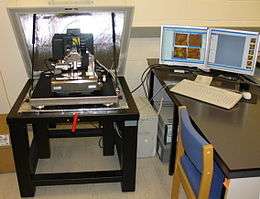Fiber analysis
Fiber analysis is a method of identifying and examining fibers used by law enforcement agencies around the world to procure evidence during an investigation. Fiber analysis is also used by law enforcement agencies to place suspects at the scene of the crime. Transfer of fiber can occur during close contact with the victim or suspect. Fiber transfers can also occur during break-ins where fibers from the intruder are caught in.[1][2] This method is usually not used to actually pinpoint an offender in an investigation as it is not as reliable as DNA.[1]
Fiber analysis does not follow any officially laid-down procedure. The most common use of fiber analysis is microscopic examination of both longitudinal and cross sectional samples. While this is the most common method of undertaking fiber analysis, others do exist. These include the burning and solubility methods. These methods are most commonly used to reveal the identity of the fiber. Fiber analysis is usually not undertaken in university labs because of the usual lack of required solvents.[2]
Methods
Scanning electron microscopy
Scanning electron microscopy (SEM) is method of photography which requires an instrument called the scanning electron microscope, which uses electrons rather than light to form an image. There are many advantages to using the SEM instead of a light microscope. Using SEM requires a large depth of field, which allows a large amount of the sample to be in focus at one time.[3]
Atomic force microscopy

Atomic force microscopy is a method which is carried out using an atomic force microscope, which is an instrument that can analyze and characterize samples at the microscopic level. The instrument allows the analyst to look at surface characteristics with very accurate resolution ranging from 100 μm to less than 1 μm.[4]
References
- 1 2 Ramsland, Katherine. "Trace Evidence". TruTV. Retrieved 5 April 2011.
- 1 2 A. Katz, David. "Study into Fiber analysis" (PDF). Chymist.com. Retrieved 5 April 2011.
- ↑ "WHAT IS THE S.E.M.?". Iowa State University. Retrieved 5 April 2011.
- ↑ "Atomic Force Microscopy: A Guide to Understanding and Using the AFM" (PDF). Texas State University. Retrieved 6 April 2011.